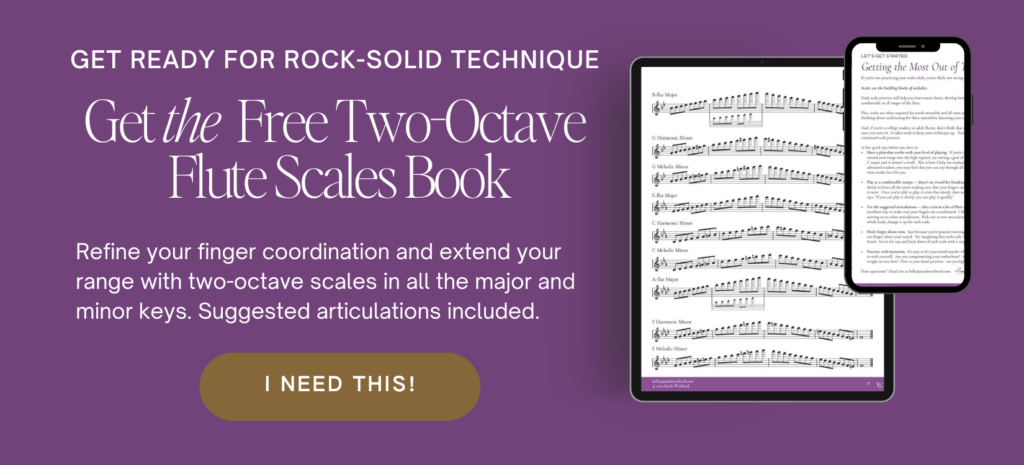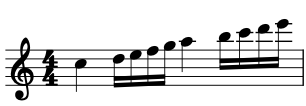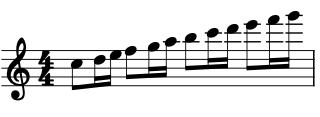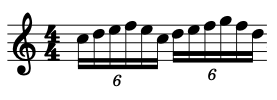As a flute teacher, I find that many, if not most, students don’t practice scales methodically, if at all. And I know that when I was their age, I found scales to be B-O-R-I-N-G. I used to dread practicing scales. I could rip up and down them, but I wasn’t practicing them with a clear intent for how they could help me learn and execute my repertoire at a higher level.
When I ask my students to play scales for me in their lessons, they often play one or all of these scenarios:
- As fast as possible
- The same rhythm every week
- One dynamic level
- No musical inflection
But practicing scales that way only proves that you can play as fast as possible in one rhythm with no musical inflection and at the same dynamic level.
Scales are the building blocks of melodies.
Practicing scales with different articulations, meters, and phrasing makes them more enjoyable and less tedious. Plus, you’ll be better prepared when you get to your repertoire.
Let’s dive into the different ways you can change your daily scale routine to get the most out of your practice time.
If you want to increase your range in the flute, I’ve got you covered with my free Two-Octave Scales for Flutists practice book.

Before jumping into the tips, remember to practice your scales musically. Phrase to the next beat and arrive at the tonic note in each octave.
Now, let’s get started!

No. 1 | Change the Notes Per Beat
One of the easiest ways to change your scales is to alter the rhythm. If you always practice in groups of 4, try practicing your scales in triplets, quintuplets, sextuples, and septuplets.
Bonus points if you can do it from memory, but remember, there’s no blue ribbon for speed. When you change the number of notes per beat, take your time, especially when playing 6 or 7 notes per beat.
No 2. | Change the Rhythm
We tend to practice scales with an even distribution of notes per beat, i.e., all quarter notes, all eighth notes, or all sixteenth notes. But, by changing the rhythm you play for your scales, you add some spice to your daily scales practice.
Try adding different rhythms within each measure of your scales, like the patterns shown below.



No. 3 | Use Different Articulations in Your Scales
Instead of playing all single-tongued or slurred, try playing slur 2, tongue 2. Or, tongue 1, slur 2, tongue 2, slur 2, so that if you’re playing sixteenth notes, the slur occurs on the middle two sixteenth notes.
Try practicing on all “hah” tongueless attacks to find the right angle of air for every note.
Practicing your scales double-tonguing forwards and backward, as well as triple tonguing (ta-ka-ta ta-ka-ta and ta-ka-ta ka-ta-ka), provides immense benefit to your tongue finger coordination.
If you practice Taffanel & Gaubert #4, try using a different articulation for each scale.
No. 4 | Change the Note Order and Add Patterns
Rather than practice your scales in diatonic order or in thirds, try incorporating different patterns.
For example, you could play 1231, 2342, and 3453, as shown below.

You can alter this pattern so it starts with a descent first: 1761, 2172, 3213.

Try incorporating a different pattern with a different number of beats. Using a sextuplet rhythm, you could play 123431, 234542, etc.

No. 5 | Incorporate Dynamics
A beneficial way to practice scales is to change the dynamics. Practicing scales at the same dynamic can be a little bland. It can cause you to go on autopilot, lose focus, and stop listening to your tone quality as you practice.
Try practicing your scales by changing the dynamics. You can start quieter and get louder towards the peak before making a diminuendo all the way back to the tonic note.
You can start forte at the beginning, then make a diminuendo as you ascend. Then, make a crescendo back to the starting note on the way down.
Try practicing each scale up and down as one large diminuendo or crescendo.
To make things even more fun—because scales should be enjoyable, not a loathsome activity—use these suggested dynamics within each measure. If you’re practicing your scales in 4/4, try making a hairpin within each measure.
No. 6 | Change the Meter and Metric Inflection
Instead of playing with four beats per measure, try playing in other meters, such as 2/4, ¾, or 5/4. We often play scales in simple meters, but playing scales in a compound meter like 6/8 or 9/8 provides its own set of challenges. You have a larger beat with three smaller beats within it. The metric emphasis is different.
To make your scale practice more exciting, experiment with meters such as ⅝. Practice as 1-2-3, 1-2 and 1-2, 1-2-3. You can do the same thing with ⅞ and put the smallest beat—the one with only two eighth notes—in different places.
And for a good challenge, emphasize offbeats by having your metronome click line up with the offbeat.

No. 7 | Break up the Types of Scales You Practice Daily
If you always practice the Moyse scale pattern from Exercises Journaliers^, switch it up and try Taffanel & Gaubert #4^. Both the Moyse and Taffanel & Gaubert books offer a variety of different scales and patterns. Taffanel & Gaubert #1 and 2 are excellent for isolating 5-note scale patterns.
Walfrid Kujala’s Vade Macem incorporates different patterns in the scales. No two scales have the same articulation or pattern. Another book I highly suggest is Reichert’s 7 Daily Studies. Like the other books mentioned, it uses different patterns to help you quickly go through each key.
*BONUS TIP* – Inverted Scales
Practice your scales inverted by starting at the top, descending, and returning to the bottom.
And, if you’re able, I highly suggest practicing your scales up to high D and down to low B (if you have a B foot joint).
There are so many different patterns used in music. Practicing your scales in various ways ensures you’ll be prepared when tasked with quickly learning new repertoire.
Remember, you should practice your scales with intention. If you find your mind wandering, try these tips to keep your mind and fingers engaged.
⬇️ And if you’re looking to work on your scales, check out my Free Two-Octave Scales for Flutists, linked below. ⬇️


^ denotes an affiliate link.
+ show Comments
- Hide Comments
add a comment